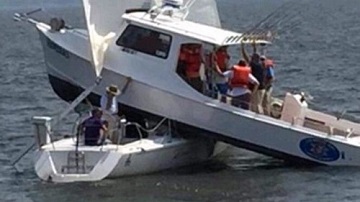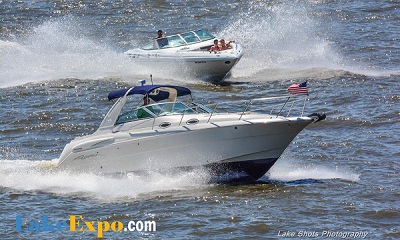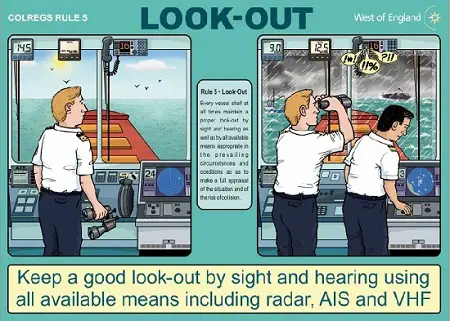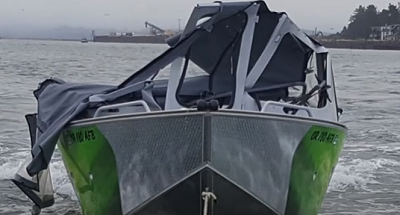When two boats approach one another, the captain of each vessel is responsible for avoiding a collision. First of all, it’s the responsibility of the captain of the two boats to avoid collisions. The captain should be always on the watch to see that no one crosses his path and has to make sure that his boat is completely clear of other vessels in case they do cross.
The question is: who’s at fault when the boats collide? It might seem to be an easy answer, but it really depends on whether or not both captains were negligent. Who do you think should be responsible for this situation?
Who is responsible for avoiding a collision between two boats?

Two boats should follow the law when it comes to avoiding a collision. Both boats have to be aware of one another and not operate in an unsafe manner. In case there is a boating accident, who is responsible? It’s up to both boats because they are equally at fault for not following safety guidelines. The law is clear on this issue. However, there is more or less punishment depending on the situation.
What is the boater’s responsibility in avoiding a collision?
If you’re wondering how to avoid boat collisions and stay out of trouble with the law, read on.

Follow rules of navigation
Follow the rules of navigation at all times. For example, if you come across an obstruction or another boat that’s in your way, you must be sure to change course and steer around it. In addition, don’t boat at night without the proper equipment such as a navigation light and a sound-producing device (whistle).
Head-On situation
When two boats approach one another head-on, try to pass port to port, so that you have the other craft just off your port (left) side. You can also slow down and maintain a steady course if necessary, as long as it’s safe to do so. Don’t make any sudden moves or do anything that might confuse the other boat.
Crossing situation

The crossing situation is a bit more tricky. If you are a give-way boat, you should keep changing your speed and course, so that the other boat passes you at an angle rather than directly in front of you. If you are a stand-on boat, you should maintain your course and speed.
The boat which is on the other’s starboard side is a stand-on boat, and the boat which is on the other’s port side is a give-away boat.
Overtaking
When overtaking another boat, you should stay clear of the other boat until you are able to pass at a safe distance. In a word, Keep out of the way.
When being overtaken you should also keep a good lookout, and maintain your present course and speed. The overtaking boat may sound like a foghorn, or signal in some way that it is about to pass you.
Follow ENC chart
If you are boating in an area where ships and barges frequently travel, make sure that you’re able to identify any obstruction (buoys, gas, or water pipes) clearly marked as a navigational aid. Pay close attention to navigational aids.
When you’re out on the water and don’t know what to do, just follow your chart. Charts are a great way to avoid getting lost or running into any navigational hazards in unfamiliar waters. They can be found at most marinas for free so they’re not hard to come by. Just make sure that when you head out onto the open sea, it’s with one of these nautical charts handy – no matter how old school it seems.
Keep Lookout
Everyone on board should keep a sharp lookout in all directions. A designated person can be the “lookout.” The lookout should call out, or signal with hand signals if necessary, anything that is seen.

In congested traffic, slow down, maintain a steady course and speed, and keep out of harm’s way. Keep a good lookout, and signal to other boats if necessary.
Be alert when onboard
If you’ve been out on the water for a long time, or if you’re tired, stressed, or have been drinking alcohol, it’s best to take a rest. If something does happen, you will be less able to deal with the situation effectively. Stay alert at all times.
Keep in touch with other boat
Let’s try to be careful on the water. If you see any hazards, please report them to proper authorities as soon as possible. You can do this by contacting your VTS (Vessel Traffic Service) or calling the Coast Guard directly and giving them a call if there is an emergency such as someone overboard.
If you are stuck in debris, stay calm and alert other boats that there is a problem. Also, alert the authority as soon as possible.
Avoid congested area
Boats navigating in congested water areas must take all necessary precautions to avoid collisions. These areas are high-density traffic zones, which means that if navigation is not carried out properly, there’s a good chance you’ll collide with another vessel.

Stay clear of crowded anchorages. Try to keep a good distance from other anchored boats. This will help you avoid getting tangled in their lines or running over their anchors.
Check your boat and its equipment
It’s not just the boat that you need to check. When your equipment is in order, it will be easier to enjoy a successful boating trip with family and friends.
Your boat should always be kept seaworthy, and free of hazardous conditions such as broken equipment that might cause it to drift away, or sink quickly in an emergency.
Conclusion
Who is responsible for avoiding a collision between two boats? It’s you. Be aware and take care to follow the rules of navigation. If you are in charge, make sure your crew knows how to avoid collisions while also ensuring that they remain safe. With these simple tips, we can help keep each other out of harm’s way on the water.
